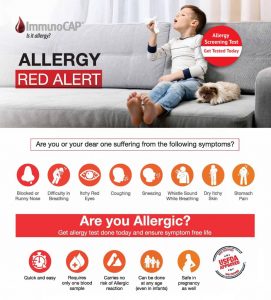Types of Allergies

Allergies, though seemingly harmless, have the potential to impact an individual’s quality of life significantly. From mild discomfort to severe reactions, various types of allergies affect millions worldwide.
To battle the potential negative effects of allergies, first, you must have proper knowledge about their types, causes, and symptoms. This comprehensive article empowers you to navigate the intricacies of allergies.
Read on as we delve into the various types of allergies, common allergy symptoms, and emergency treatments to avoid a life-threatening situation.
How to identify allergies?
Everyday products, including food, daily-use objects, or medication, usually cause allergies. These substances, which lead to allergic reactions, are known as allergens. Hence, by identifying the cause of allergies, you can take proper measures to avoid those allergens.
To identify potential allergens, you must adopt the habit of noticing the changes in your body. Allergic reactions can vary in intensity since some responses can only be limited to minor itchiness or redness.
You can uncover unknown allergies by noticing sudden changes like inflammation, redness, or itchiness. If you find any possible allergies, get them checked through proper diagnosis and consultation by an allergist.
Common Symptoms of Allergies
In most cases, an allergic reaction can occur within a few minutes of exposure to the allergen. While the extent of the reaction depends on the individual, the symptoms shown by most allergies are pretty similar.
Here are some of the most common allergy symptoms:
- Sneezing
- Runny or stuffy nose
- Itching in different parts of the body
- Swelling, especially around facial parts or the throat
- Coughing and wheezing
- Diarrhoea (Common in food allergies)
- Redness at different parts of the body
Types of Allergies
Allergies can cause a wide range of allergic reactions, depending on the exposure method to the allergen. As a result, allergies have been categorised into various types based on their respective allergens.
6 Types of Allergies
Food Allergy
Food allergies occur when our immune system has a reaction to specific proteins in certain foods. Common allergens include peanuts, tree nuts, shellfish, eggs, and dairy products. Typical food allergy symptoms include throat swelling, itching, or anaphylaxis.
Skin Allergy
Allergic reactions that affect the skin can result from direct contact with the allergens. For skin allergies, allergens include certain plants, latex, or metals. Symptoms include redness, itching, swelling, and hives on the skin.
Drug Allergy
Some individuals may develop allergies to medications. These medications can range from antibiotics and over-the-counter medicines to prescribed ones. Allergic reactions can lead to skin rashes, hives, or more severe symptoms.
Dust Allergy
As the name suggests, dust allergies are mainly caused by irritants present in the air. When inhaled, allergens like dust mites, mould spores, pollen, and pet dander can cause dust allergies. While dust allergies can occur throughout the year, their cases are more frequent in specific seasons when allergens’ content in the air increases. Symptoms often include sneezing, a runny or stuffy nose, and itchy eyes.
Insect Bite Allergy
Insect stings from bees, wasps, hornets, or fire ants can trigger allergic reactions. For those with insect bite allergies, stings can cause localised swelling, hives, and, in severe cases, anaphylaxis.
Allergic Rhinitis
It is also more commonly known as hay fever. The usual symptoms of allergic rhinitis are sneezing, a runny nose, and itchy or watery eyes. Just like dust allergies, hay fever is also caused by inhaling specific allergens like pollen, pet furs, and moulds.
Test for allergies
Determining the specific allergens responsible for a person’s symptoms is crucial for effective management. Generally, doctors prescribe one of these three allergy tests:
- Skin Prick Test: Tiny amounts of allergens are introduced under the skin’s surface to observe reactions.
- Blood Test (RAST or ImmunoCAP): This test measures the level of specific antibodies (IgE) produced in response to allergens.
- Patch Test: This test identifies contact allergens causing skin reactions. Patch test does not require needles and is used to detect delayed-type allergic reactions.
Even with minor symptoms, it is better not to ignore allergies. Through timely diagnosis, personalised management, and prompt medical attention, you can minimise the impact of allergies.














